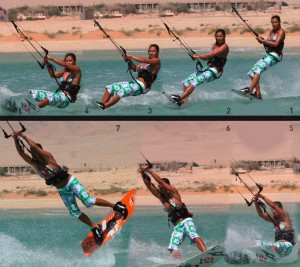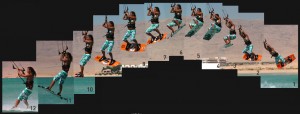Unhooked Jump
Jumping unhooked requires all the same core skills as jumping hooked in. In a way it’s a great method of finding out your strenght and weaknesses and to some degree it may improve your hooked in aerial adventures.
The most obvious and main difference is the take off. Without the ability to sheet the bar out as you approach there is a possibility that you´ll get overpowered before you have the chance to stelle into a nice strong edge against the pull of the kite. To make matters worse, if in anticipation of this overpowered-ness, you trim your kite just a bit too much you´ll end up with no power and not a hope in a hot place of flying.
Anyway, let´s move on to the technique!
- With the kite around 11 o’clock and with good board speed you push the nose of the board off the wind. Extend your front leg and let the kite pull you up over the board. Now that the board is pointing at the kite there should be some slack in the lines so you can unhook.
- Push the bar down so your chicken loop can fall free (remove the donkey dick if you havn’t already done that). Don’t look down since this can make your shoulders come forward.
- Now send the kite back and drop your weight back over the trailing foot, pushing the board away from you.
- Twist your shoulders and hips upwind and drop the body weight upwind of the board, resisting the pull of the kite by pushing back with your feet. Your front leg is still extended and try to keep your elbows in near your waist.
- As your arms get pulled up it’s time to get airborn or you’ll just be pulled over the board.
- Explode up off your back leg, pushing your heel hard against the edge for that last bit of resistance.
- The kite wins and you are plucked into the air. As you rise pull down hard on your front hand to redirect the kite and stop any unwanted pendulum activity.
Alright, so we are now airborn. Let’s move on to the next steps.
1. Concentrate on redirecting the kite with your front hand. This is very important and requires much more effort than you can imagine.
2. Still on the way up start to lift your knees whilst steering the kite back above you.
3. Now you should have the board in front of you and you should start feel more balanced and in control.
4. As you approach the apex of the jump the kite is not lifting so much so you can start to pull down on the bar.
5 & 6. At the very top of the jump you should now have managed to pull the bar down to you and from here you can focus on the landing.
7 & 8. As you start to descend try to bold your position and keep the kite flying forward.
9 & 10. Drop your legs and start to hang off/pull on your front hand to get the kite diving down.
11 & 12. Just before the landing point your board and drop your back leg (eg. whilst still diving the kite down with your front arm. Yet again you’ll need to put a lot of effort into the dive, as the kite will not respond like you’re used to)
A perfect landing off the wind. Now you can gather your thoughts, hook back i, carve the board up and across the wind and fly the kite.
Common problems
- The first most common problem is getting pulled off your edge during the take off. If you look at the kite, it twists your body back across the wind and results in you being lifted over the board and loosing your edge. Try to get really low and keep your elbows tucked in. This will be easier if you lean your weight back as you bear away to unhook, as then when you suddenly carve upwind your front leg will be straight and your weight will be low. Once you feel your arms start to extend pop up, as this is definitely the last moment possible to slavage your jump.
- Redirecting your kite when you take off and diving it as you land is much harder hanging from a bar with your hands in the middle. As a result you may find that on take off it’s very hard to get the kite back above you, so you pendulum and drop. If you hold your edge and jump before you get pulled forward this will help. Try using both hands to steer. So if you want to pull on your front hand, push away with your back hand. The result is a turning of the wrists, which will make lfe considerably more pleasant.

Leave a Reply